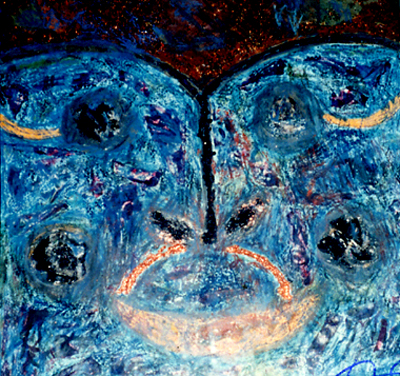
When spaces
Between walls, between words, between figures
Make room, make sense, take shape
When chair
Is site, is sitting, is sitter
And arm
Is armor, is armchair, is armature
Is sweet-smelling kitchen, warm laughter, overflowing
Pink
And crocodile hiding under the bridge
Is river boat, stepping stone, trail of ink
We move in unmeasured time
The flight of stairs, the flight of metaphors, the
Flight of
Tapestries
Only half-conscious
Of gravity’s embrace
As we step on the landing
(With outstretched dragonfly wings)
Sid Gomez Hildawa
“Why architect is poet is painter (but not automatically)”
On the other hand, maybe it was almost automatic for Sid Gomez Hildawa. There seemed to be no marked difference between his training in the hard science and applied art of architecture (training, because I am not familiar with his work as architect), and the poetry of spaces and absences he wrote. He was always designing and constructing his poems, the metaphor of architecture pervaded his literature. In the right column of his blog, which was a place for more or less permanent images or text, he put in this quote from a Paul Moldoon interview, with the heading, POETRY & ARCHITECTURE:
"...In buildings, as in poems, there's a tendency for that feature over there on the right-hand side to echo that feature over there on the left, and it may have to do with aesthetics, of course, but it's more likely to have to do with pure physics. That's to say, if you don't have that balance then the whole thing is going to fall down. I find thinking in these ways quite useful when I'm building poems. They're bridges. Skyscrapers..." (Paul Muldoon, as interviewed in The Paris Review, Issue 169.)
In fact I didn’t know or simply forgot Sid was an architect by profession, because I first encountered him, and got to read him, and then always thought of him, as a poet. Still we were not that familiar as friends—we knew each other mainly through our work, and in the very few instances we did a collaboration of some sort. The earliest I remember is the last Chromatext show at CCP, which he curated as the Center’s department head for Visual, Literary, and Media Arts. Chromatext is, of course, the poetry-and-art interaction exhibit and event conceived by the Philippine Literary Arts Council. And the 2007 Chromatext (Reloaded) was a revival after an absence of some ten years. Jean Marie Syjuco and Krip Yuson helped Sid contact and coordinate with poets and artists, and I was trying to meet the deadline at the last hour. Sid and Jean Marie were already hanging the framed artworks (other artists had earlier completed their installations), while I kept updating Sid that my participation of one poem and one artwork was just about done in the large-format digital printing shop on Vito Cruz just across CCP. My piece was the relatively new poem then, titled “War Correspondent,” whose visual counterpart I request friend Dan Pinto (editor at Senate publications and digital art enthusiast) to execute on his computer, composed mainly of the latest photographs of the Iraq war in digital collage with Dürer’s engraving of the Four Horsemen of the Apocalypse. Sid assured me over the cellular phone they were waiting for my piece. Sure enough I was able to hand in the Sytropore-backed 24x38 in. print at about 10 pm, just in time for the opening the following day.
My second memorable “collaboration” with Sid was for the “Pictura Poiesis” show in November last year at MagNet Katipunan. I had just delivered a lecture of sorts on ekphrastic poetry in Marj Evasco’s graduate class on literature and its sister arts. I was discovering a new stimulus for a series of poems, either paintings or photographs that I kept “stealing” from friends’ blogs or photo collections in online hosting sites. Pictura Poiesis was at Marj’s instigation—why not read poems based on paintings, while showing the paintings or pictures of them, at the MagNet Poetry Mondays hosted by Joel Toledo? Four of Marj’s graduate students were to read: Noelle Leslie de la Cruz, Ida Anita del Mundo, Kristian Abe Dalao and Sid. On hand to support them were the older poets, Marj Evasco, Beni Santos, and Poetry Night host Joel Toledo. Marj’s students prepared their own Powerpoint presentation of their poems and paintings, and those of Marj’s and Beni’s, and Marj handed me the CDs in a quick meeting at Ateneo. Artist Rock Drilon, owner of MagNet, assured us the projection equipment in the upstairs café was ours for that Monday night. But I had a trip out of town during the intervening weekend and I still had to integrate the Powerpoints into a single presentation by Friday. The last chore was to pick up Joel’s poems and the digital images of the Van Gogh they were based on, at his pad, because he was very busy and I had to work at putting together everything in Keynote presentation on my Powerbook.
Happy Mondays Poetry Night at MagNet was one great night. The audience were rapt (since they had to look at the paintings projected onscreen while listening to us), it was well-attended, everybody had fun, especially the poets. One great night, Sid told me so over beer. I seldom visit the Cultural Center offices where I could run into Sid, so Pictura Poiesis poetry night at MagNet, November 5, 2007 (my birthday), was the last time I saw poet-architect Sid Gomez Hildawa.
It is not difficult to retrieve memories when a poet passes away (despite the suddenness and the unnecessary-ness of it) precisely because he is a poet, he is always writing his memory. But it is even less difficult now that memory drifts and lurks in electronic space. Sid started blogging earlier than I did (he started in 2004, I in 2006), and we have linked each other as well as our other friends to our own sites. We are mutually “clickable.” So I clicked his link (you may, too), and here are his poems, culled from his online journal and other places in the Net. Let his memory speak.
Builiding A House
Pack up your day-to-day activities in bundles, the way
one would basket clothes for the laundry;
grouping coloreds and whites, matching socks and outfits.
Measure the bulk, trace the shapes each bundle takes,
then see how they can be arranged:
some easily side by side, while some on top of others,
like displaying boxes in a store window. Translate these
into drawings and get a building permit from City Hall.
(That’s the easy part.)
Gather all your friends and relatives to a barbecue party
at your vacant lot. Before dessert is served, begin digging
the foundation, then hand over the shovel to your contractor
who always arrives late. Give him twice the amount of time
he estimates it will take him to complete the job. Cut his budget
in half by providing the materials yourself: skin for walls,
eyes for windows, mouth and ears and orifices for doors,
feet for floors, intestines for stairs, eyelids and a head full of hair
for awnings and a roof. Then when it finally resembles you,
call it home. Otherwise, have it rented out and build another.
(This poem is part of the collection that won Second Prize for Poetry in the 2006 Palanca Awards, form Ian Cosocot’s Philippine Literature site )
 A Pacita Abad painting courtesy of Artes de Filipinas.com
A Pacita Abad painting courtesy of Artes de Filipinas.comHow to be a Ceiling
On her hospital bed, Pacita Abad deciphered
the ceiling as though it were a dead sea scroll
testament on the meaning of upside-
down. We seldom look up long enough,
she said, taking a floor mop for a brush
and painting multi-colored circles and spirals
on the whitewashed surface the way one
would curl up rainbows, spin the iridiscence of corals
into nautiluses, fasten mirror buttons to bottlecaps
as emblems to the bubbly fizz of soda water;
while she sang the groovy hits of the boogie-woogie
sixties, made trapunto with her hospital gown,
fixing it beside the smoke alarm. Next morning,
nurses came and took her pulse, blood pressure.
Doctors in white examined her heart. Beloved Jack
brought in a bouquet of blooms, looked up,
and marvelled at the Sistine Chapel psychedelic.

How to Be a Door
Hinge your life on something
as steadfast as a jamb
but know which way to swing.
(Those who swing both ways
belong between the dining hall
and the kitchen.) Hold your breath
when you are locked, inhale deeply
with every knock that isn't answered
with "come in." Be still
when there is no reply from the innkeeper
of all things. Your name is Portal
so with your body keep out sickness
and greed, and builders who do not know
how to hammer a house with quiet words.
Let sorrow pass, and youth, and the goldest giraffe
who bends low to nibble from a lady's hand,
that all may enter who have traveled worlds
to be astonished; weary now of boulevards
that look out to the sea but never wave;
finally stepping out of solitude into shade,
shaking hands with all they meet inside, all
who have come before them, all who must dwell.
(Poem printed on acetate sticker and installed on glass door of CCP Gallery for Chromatext:Reloaded)



2 comments:
This is wonderful. Glad I stumbled across your threshold!
Hi Apprentice,
Thank you for writing and for the honor of your visit. Since I don't know you, I went to all your blogs and read... I will go back. We're (mostly) Catholic here in the Philippines so I will pray--my little contribution for the whole universe to conspire that you get well, though I know your writing helps, I think more than anything else, apart of course from your family's and friends' love.
Marne L. Kilates
Post a Comment